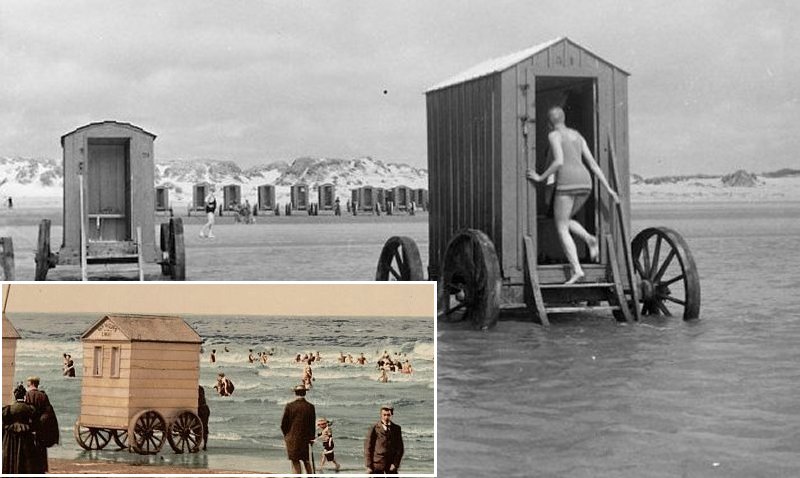What Were Victorian Bathing Machines?
AncientPages.com - Starting in the 1750s, beaches were suddenly filled with so-called bathing machines. These were basically wooden changing booths, with wheels and wooden steps that led inside.
During the Victorian era of British history, a period associated with Queen Victoria's reign from 20 June 1837 until her death, on 22 January 1901 plenty of bathing machines were designed to prevent anyone from seeing a woman in her swimsuit before she slipped into the waves.
These bathing machines were invented in times when most people still swam naked. Even when early forms of swimwear did start being introduced, society conveniently decided that a 'proper woman' should not be seen on the beach in her bathing suit.
So, something had to be done and bathing machines seemed like a perfect solution. Once the woman got inside the bathing machine she must change into a swimsuit. Then, the four-wheeled box would be rolled out to sea, usually by horse or sometimes human power.
Once the machine plunged far enough out into the ocean waves, the woman could quickly dive off the float.
On some beaches, inexperienced swimmers were offered the service of a "dipper", a strong person of the same sex who would escort the bather out to sea in the cart and essentially push them into the water and yank them out when they were done.
When legal segregation of bathing areas in Britain ended in 1901 and it finally became acceptable for both genders to bathe together, it was the beginning of the end for the bathing machine.
By the 1920s bathing machine ceased to be used. Yet, even today, you can sometimes see bathing machines on the beach.
Copyright © AncientPages.com All rights reserved. This material may not be published, broadcast, rewritten or redistributed in whole or part without the express written permission of AncientPages.com
More From Ancient Pages
-
 New Interpretation Of A 4,000-Year-Old Cemetery In Present-Day Slovakia
Archaeology | Dec 21, 2022
New Interpretation Of A 4,000-Year-Old Cemetery In Present-Day Slovakia
Archaeology | Dec 21, 2022 -
 Oldest Houses Of Nea Paphos In Cyprus – Discovered
Archaeology | Apr 12, 2017
Oldest Houses Of Nea Paphos In Cyprus – Discovered
Archaeology | Apr 12, 2017 -
 The Mysterious Books Of Prophecies Of The Knights Templar – Where Are They Hidden?
Ancient Mysteries | Mar 26, 2022
The Mysterious Books Of Prophecies Of The Knights Templar – Where Are They Hidden?
Ancient Mysteries | Mar 26, 2022 -
 Great Sakya Library Is Home To 84,000 Scrolls Left Untouched For Hundreds Of Years
Featured Stories | Jul 22, 2021
Great Sakya Library Is Home To 84,000 Scrolls Left Untouched For Hundreds Of Years
Featured Stories | Jul 22, 2021 -
 Clurichaun – Little Naughty And Drunken Fellow Akin To Leprechaun In Irish Folklore
Featured Stories | Sep 13, 2019
Clurichaun – Little Naughty And Drunken Fellow Akin To Leprechaun In Irish Folklore
Featured Stories | Sep 13, 2019 -
 Rare 3,000-Year-Old Gold Bead Found On Temple Mount By Young Boy
Archaeology | Nov 30, 2020
Rare 3,000-Year-Old Gold Bead Found On Temple Mount By Young Boy
Archaeology | Nov 30, 2020 -
 Mysterious Hornet Spook Light In Missouri
Featured Stories | Jun 26, 2024
Mysterious Hornet Spook Light In Missouri
Featured Stories | Jun 26, 2024 -
 Dwarka – Pre-Harappan City That Could Rewrite The History Of The World
Civilizations | Aug 19, 2014
Dwarka – Pre-Harappan City That Could Rewrite The History Of The World
Civilizations | Aug 19, 2014 -
 Stonehenge May Have Aligned With The Moon As Well As The Sun
Featured Stories | Jun 4, 2024
Stonehenge May Have Aligned With The Moon As Well As The Sun
Featured Stories | Jun 4, 2024 -
 Rare Artifacts Found In Nottingham’s Mysterious Caves On Display For The First Time
Archaeology | Feb 7, 2024
Rare Artifacts Found In Nottingham’s Mysterious Caves On Display For The First Time
Archaeology | Feb 7, 2024 -
 What Can Archaeology Tells Us About Climate Change?
Archaeology | Aug 9, 2021
What Can Archaeology Tells Us About Climate Change?
Archaeology | Aug 9, 2021 -
 2nd Century Inscription Unearthed At Forum Of Ancient City Of Philippopolis, Bulgaria
Archaeology | Oct 21, 2019
2nd Century Inscription Unearthed At Forum Of Ancient City Of Philippopolis, Bulgaria
Archaeology | Oct 21, 2019 -
 Cooking, Roasting And Eating Of Root Plants Is 120,000-Year-Old Habit
Archaeology | Jun 7, 2019
Cooking, Roasting And Eating Of Root Plants Is 120,000-Year-Old Habit
Archaeology | Jun 7, 2019 -
 5 Traces Of Ancient Ancestors That Still Exist In All Human Bodies Today
Featured Stories | Jan 23, 2023
5 Traces Of Ancient Ancestors That Still Exist In All Human Bodies Today
Featured Stories | Jan 23, 2023 -
 Archaic Temple (Part Of God Poseidon’s Sanctuary) At The Kleidi-Samikon Site In Greece – Unearthed
Archaeology | Jan 12, 2023
Archaic Temple (Part Of God Poseidon’s Sanctuary) At The Kleidi-Samikon Site In Greece – Unearthed
Archaeology | Jan 12, 2023 -
 Mysterious Secret ‘Square’ Discovered Beneath Avebury Stone Circle
Archaeology | Jun 30, 2017
Mysterious Secret ‘Square’ Discovered Beneath Avebury Stone Circle
Archaeology | Jun 30, 2017 -
 Mysterious And Unexplained Encounter With Unusual Tiny Beings In Italy – A Strange Connection – Part 2
Featured Stories | Jan 18, 2022
Mysterious And Unexplained Encounter With Unusual Tiny Beings In Italy – A Strange Connection – Part 2
Featured Stories | Jan 18, 2022 -
 Ancient Mayan City Filled With Palaces, Pyramids And Plazas Discovered On Construction Site In Mexico
Archaeology | May 27, 2022
Ancient Mayan City Filled With Palaces, Pyramids And Plazas Discovered On Construction Site In Mexico
Archaeology | May 27, 2022 -
 Oldest Known Human-Made Nanostructures Found In Ancient Artifacts In Tamil Nadu
Ancient Technology | Nov 23, 2020
Oldest Known Human-Made Nanostructures Found In Ancient Artifacts In Tamil Nadu
Ancient Technology | Nov 23, 2020 -
 Cyrus The Great: Founder Of Achaemenid Empire Who Conquered Medians, Lydians And Babylonians
Featured Stories | Mar 21, 2019
Cyrus The Great: Founder Of Achaemenid Empire Who Conquered Medians, Lydians And Babylonians
Featured Stories | Mar 21, 2019


